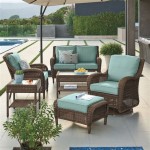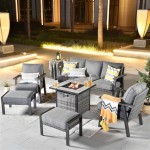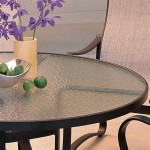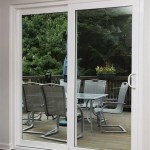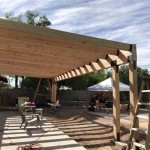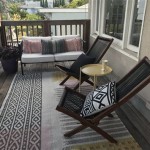Southern Patio Flower Pots: A Comprehensive Guide
Southern patio flower pots are not merely containers for plants; they are integral components of outdoor living spaces, particularly in regions characterized by warm climates and extended growing seasons. The selection and utilization of these pots contribute significantly to the aesthetic appeal, functionality, and overall health of the plants they house. This guide provides a detailed overview of Southern patio flower pots, encompassing materials, styles, considerations for plant health, and design implementation.
Selecting the Right Material for Southern Climates
The material composition of a flower pot is a critical factor, particularly in the Southern United States, where high temperatures, intense sunlight, and varying humidity levels can significantly impact the performance and longevity of both the pot and the plant. Different materials offer distinct advantages and disadvantages, and understanding these nuances is essential for making informed decisions.
Terracotta: Terracotta, derived from baked clay, is a classic and widely utilized material for flower pots. Its porous nature allows for excellent airflow and drainage, preventing waterlogging and reducing the risk of root rot, a common problem in humid environments. However, this same porosity means terracotta pots dry out more quickly, necessitating more frequent watering, especially during the hottest months. Terracotta is susceptible to cracking in freezing temperatures, making it less suitable for regions with occasional frosts. The reddish-brown hue of terracotta also complements a variety of plant types and architectural styles, adding a natural and rustic aesthetic.
Plastic: Plastic pots offer a cost-effective and lightweight alternative to terracotta. They are available in a wide range of colors, shapes, and sizes, providing versatility in design. Plastic is non-porous, retaining moisture for longer periods, which can be beneficial in drier climates or for plants that prefer consistently moist soil. However, this also means that drainage is less efficient, requiring careful management to avoid overwatering. In the intense Southern sun, some plastics can become brittle and fade over time. UV-resistant plastic pots are available and are a worthwhile investment for enhanced durability.
Resin: Resin pots are often designed to mimic the look of more expensive materials like terracotta, stone, or ceramic, but they are significantly lighter and more durable. They are resistant to cracking, chipping, and fading, making them well-suited for outdoor use in the South. Resin pots generally retain moisture well, similar to plastic, and drainage should be carefully monitored. The versatility of resin allows for intricate designs and textures, adding visual interest to patio arrangements.
Ceramic: Ceramic pots are typically glazed, making them non-porous and water-resistant. This characteristic allows for excellent moisture retention and reduces the frequency of watering. Ceramic pots are available in a vast array of colors, patterns, and sizes, making them a highly decorative option. However, they are more expensive than plastic or terracotta and can be quite heavy, especially when filled with soil. Like terracotta, ceramic pots are susceptible to cracking in freezing temperatures.
Concrete and Stone: Concrete and stone pots are exceptionally durable and provide a substantial, permanent presence in the landscape. They are resistant to weathering and can withstand extreme temperatures. These materials offer excellent insulation, protecting plant roots from temperature fluctuations. However, concrete and stone pots are very heavy, making them difficult to move, and they can be more expensive than other options. Drainage is often less efficient, requiring attention to soil composition and watering practices.
Optimizing Plant Health in Southern Patio Flower Pots
Beyond the material of the pot, several factors contribute to the health and vitality of plants grown in Southern patios. Proper drainage, soil selection, and watering techniques are crucial for success.
Drainage: Adequate drainage is paramount to prevent root rot and ensure healthy plant growth. All flower pots, regardless of material, should have drainage holes at the bottom. If the existing holes are insufficient, they can be enlarged. Adding a layer of gravel or broken pottery shards to the bottom of the pot can further improve drainage. Using a well-draining potting mix specifically formulated for container gardening is also essential.
Soil Selection: The type of soil used in a patio flower pot directly impacts plant health and growth. Garden soil is generally not suitable for containers as it tends to compact and does not drain well. A soilless potting mix, composed of ingredients like peat moss, perlite, and vermiculite, provides excellent drainage, aeration, and moisture retention. The specific composition of the potting mix should be tailored to the needs of the plants being grown. For example, succulents and cacti require a very well-draining mix, while moisture-loving plants benefit from a mix with higher water-retention capacity.
Watering Techniques: Watering frequency and quantity are critical considerations in the South, where high temperatures and humidity can rapidly deplete soil moisture. The “finger test” is a simple and effective method for determining when to water: insert a finger into the soil to a depth of about an inch. If the soil feels dry, it is time to water. Water thoroughly until excess water drains out of the drainage holes. Avoid overhead watering, as this can promote fungal diseases. Instead, water at the base of the plant, directing the water towards the soil. Consider using a drip irrigation system or a soaker hose for larger containers to ensure consistent and even watering.
Fertilization: Plants grown in containers rely on the gardener to provide essential nutrients. Regular fertilization is necessary to support healthy growth and flowering. A slow-release fertilizer incorporated into the potting mix at planting can provide a steady supply of nutrients over several months. Liquid fertilizers can be applied regularly during the growing season, following the instructions on the product label. The specific type and frequency of fertilization should be tailored to the needs of the plants being grown. For example, flowering plants benefit from a fertilizer with a higher phosphorus content.
Sun Exposure: Southern patios often receive intense sunlight, and it is essential to select plants that are well-suited to the prevailing light conditions. Plants labeled as "full sun" require at least six hours of direct sunlight per day, while "partial shade" plants prefer four to six hours of sunlight, and "shade" plants thrive in less than four hours of sunlight. Consider the orientation of the patio and the amount of sunlight it receives throughout the day when selecting plants. Using shade cloth or strategically positioning plants can help protect them from excessive sun exposure.
Integrating Southern Patio Flower Pots into Design
The aesthetic arrangement of flower pots contributes significantly to the overall appeal of a Southern patio. Combining different sizes, shapes, and colors of pots can create visual interest and enhance the ambiance of the outdoor space. Careful consideration should be given to the architectural style of the home and the existing landscape when selecting and arranging flower pots.
Pot Groupings: Grouping flower pots of varying sizes and shapes can create a more dynamic and visually appealing arrangement than using solitary pots. Odd numbers of pots, such as three or five, tend to be more aesthetically pleasing. Consider using pots of different heights to add dimension and prevent the arrangement from appearing flat. Mixing materials, such as terracotta, resin, and ceramic, can also add visual interest. Layering plants with different textures, colors, and heights within the grouped pots further enhances the arrangement.
Color Coordination: Coordinating the colors of the flower pots with the colors of the plants, the house, and the surrounding landscape can create a cohesive and harmonious design. Neutral-colored pots, such as terracotta, gray, or white, provide a versatile backdrop for showcasing the plants. Boldly colored pots can add a pop of color and create a focal point. Consider using complementary colors to create a vibrant and eye-catching arrangement.
Plant Selection for Southern Aesthetics: Selecting plants that thrive in the Southern climate and complement the overall design aesthetic is crucial. Tropical plants, such as hibiscus, bougainvillea, and mandevilla, are well-suited to warm temperatures and add a vibrant, exotic touch. Native plants, such as azaleas, camellias, and magnolias, are well-adapted to the local climate and require less maintenance. Herbs, such as rosemary, thyme, and lavender, are fragrant and useful additions to a Southern patio garden. Consider using a mix of annuals, perennials, and shrubs to create a long-lasting and visually interesting display.
Vertical Gardening: Vertical gardening techniques, such as using hanging baskets, wall planters, and trellises, can maximize space and add a unique dimension to a Southern patio. Hanging baskets are ideal for displaying trailing plants, such as petunias, impatiens, and verbena. Wall planters can be used to create a green wall, adding texture and visual interest to a blank wall. Trellises can support climbing plants, such as clematis, jasmine, and climbing roses, creating a beautiful and fragrant backdrop.
Placement and Spacing: The placement of flower pots on a Southern patio should be carefully considered to maximize their impact and functionality. Position pots strategically to create focal points, define pathways, and provide privacy. Allow adequate spacing between pots to ensure proper airflow and prevent overcrowding. Consider the mature size of the plants when determining spacing, and prune regularly to maintain a tidy and well-maintained appearance.
By carefully selecting the right materials, optimizing plant health, and integrating flower pots into a cohesive design, individuals can create a beautiful and thriving Southern patio that enhances their outdoor living experience.

Home By Ames
Southern Patio Tibot 14 5 Barrel Planter 3 Pack Costco

Southern Patio Westlake Large 20 5 In X 15 56 Qt Silver With Broe Trim High Density Resin Outdoor Planter Hdr 046868 The Home Depot

Home By Ames

Southern Patio 16 Inch Square Rustic Resin Outdoor Flower Planter 3 Pack Com

Southern Patio Westlake Large 16 In X 46 Qt Silver With Broe Trim High Density Resin Square Outdoor Planter Hdr 046851 The Home Depot

Southern Patio Pots Planters At Com

Southern Patio Hornsby Large 15 In X 13 8 31 Qt Red High Density Resin Outdoor Planter Hdr 077084a The Home Depot

Southern Patio Hdr 055457 Resin Whiskey Barrel Garden Planter Pot Gray 2 Pack Piece Pay Less Super Markets

Southern Patio Wisteria 8 Round Ceramic Planter Pot With Saucer Red 3 Pack 1 Piece Dillons Food S
Related Posts

